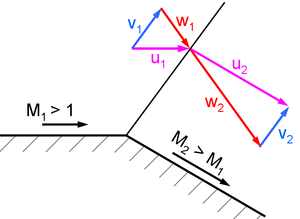Prandtl–Meyer expansion fan

A supersonic expansion fan, technically known as Prandtl–Meyer expansion fan, is a centred expansion process that occurs when a supersonic flow turns around a convex corner. The fan consists of an infinite number of Mach waves, diverging from a sharp corner. In case of a smooth, circular corner, these waves can be extended backwards to meet at a point. Each wave in the expansion fan turns the flow gradually (in small steps). It is physically impossible for the flow to turn through a single "shock" wave because this would violate the second law of thermodynamics.[1] Across the expansion fan, the flow accelerates (velocity increases) and the Mach number increases, while the static pressure, temperature and density decrease. Since the process is isentropic, the stagnation properties (e.g. total pressure and total temperature) remain constant across the fan.
Flow properties
The expansion fan consists of infinite number of expansion waves or Mach lines.[2] The first Mach line is at an angle with respect to the flow direction, and the last Mach line is at an angle with respect to final flow direction. Since the flow turns in small angles and the changes across each expansion wave are small, the whole process is isentropic.[1] This simplifies the calculations of the flow properties significantly. Since the flow is isentropic, the stagnation properties like stagnation pressure (), stagnation temperature () and stagnation density () remain constant. The final static properties are a function of the final flow Mach number () and can be related to the initial flow conditions as follows,
The Mach number after the turn () is related to the initial Mach number () and the turn angle () by,
where, is the Prandtl–Meyer function. This function determines the angle through which a sonic flow (M = 1) must turn to reach a particular Mach number (M). Mathematically,
By convention, Thus, given the initial Mach number (), one can calculate and using the turn angle find . From the value of one can obtain the final Mach number () and the other flow properties.
Maximum turn angle

As Mach number varies from 1 to , takes values from 0 to , where
This places a limit on how much a supersonic flow can turn through, with the maximum turn angle given by,
One can also look at it as follows. A flow has to turn so that it can satisfy the boundary conditions. In an ideal flow, there are two kinds of boundary condition that the flow has to satisfy,
- Velocity boundary condition, which dictates that the component of the flow velocity normal to the wall be zero. It is also known as no-penetration boundary condition.
- Pressure boundary condition, which states that there cannot be a discontinuity in the static pressure inside the flow (since there are no shocks in the flow).
If the flow turns enough so that it becomes parallel to the wall, we do not need to worry about pressure boundary condition. However, as the flow turns, its static pressure decreases (as described earlier). If there is not enough pressure to start with, the flow won't be able to complete the turn and will not be parallel to the wall. This shows up as the maximum angle through which a flow can turn. The lower the Mach number is to start with (i.e. small ), the greater the maximum angle through which the flow can turn.
The streamline which separates the final flow direction and the wall is known as a slipstream (shown as the dashed line in the figure). Across this line there is a jump in the temperature, density and tangential component of the velocity (normal component being zero). Beyond the slipstream the flow is stagnant (which automatically satisfies the velocity boundary condition at the wall). In case of real flow, a shear layer is observed instead of a slipstream, because of the additional no-slip boundary condition.
Notes
- 1 2 Impossibility of expanding a flow through a single "shock" wave: Consider the scenario shown in the adjacent figure. As a supersonic flow turns, the normal component of the velocity increases (), while the tangential component remains constant (). The corresponding change is the entropy () can be expressed as follows,
 An expansion process through a single "shock" is impossible, because it will violate the second law of thermodynamics.
An expansion process through a single "shock" is impossible, because it will violate the second law of thermodynamics. - ↑ Mach lines (cone) and Mach angle: Mach lines are a concept usually encountered in 2-D supersonic flows (i.e. ). They are a pair of bounding lines which separate the region of disturbed flow from the undisturbed part of the flow. These lines occur in pair and are oriented at an angle
 For an object moving at supersonic speeds () as it moves from point A to B (distance u·t), the disturbances originating from point A travel a distance c·t. The corresponding angle is known as Mach angle and the lines enclosing the disturbed region are known as Mach lines (in 2-D case) or Mach cone (in 3-D).
For an object moving at supersonic speeds () as it moves from point A to B (distance u·t), the disturbances originating from point A travel a distance c·t. The corresponding angle is known as Mach angle and the lines enclosing the disturbed region are known as Mach lines (in 2-D case) or Mach cone (in 3-D).
See also
- Gas dynamics
- Mach wave
- Oblique shock
- Shock wave
- Shadowgraph technique
- Schlieren photography
- Sonic boom
References
- Liepmann, Hans W.; Roshko, A. (2001) [1957]. Elements of Gasdynamics. Dover Publications. ISBN 0-486-41963-0.
- Anderson, John D. Jr. (January 2001) [1984]. Fundamentals of Aerodynamics (3rd ed.). McGraw-Hill Science/Engineering/Math. ISBN 0-07-237335-0.
- Shapiro, Ascher H. (1953). The Dynamics and Thermodynamics of Compressible Fluid Flow, Volume 1. Ronald Press. ISBN 978-0-471-06691-0.